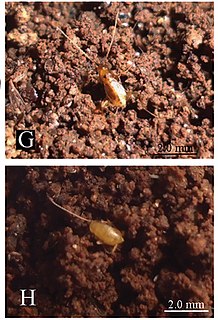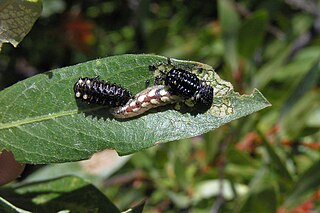
Convolvulaceae, known commonly as the bindweed or morning glory family, is a family of about 60 genera and more than 1,650 species of mostly herbaceous vines, but also trees, shrubs and herbs, and also including the sweet potato and a few other food tubers.

The insects of the beetle family Chrysomelidae are commonly known as leaf beetles, and include over 37,000 species in more than 2,500 genera, making up one of the largest and most commonly encountered of all beetle families. Numerous subfamilies are recognized, but the precise taxonomy and systematics are likely to change with ongoing research.

Bombus monticola, the bilberry bumblebee, blaeberry bumblebee or mountain bumblebee, is a species of bumblebee found in Europe.

Parasyrphus is a genus of hoverflies.

Hydrochus is a genus of water scavenger beetles in the monogeneric family Hydrochidae, sometimes placed in the Hydrophilidae as a subfamily Hydrochinae. The family Hydrochidae includes about 180 species, all of which are placed in the genus Hydrochus. Hydrochus has also been used for a fly genus in the family Dolichopodidae. This junior homonym is a junior subjective synonym of the genus Rhaphium.

Nocticola is a genus of cockroaches in the family Nocticolidae distributed in Africa, south-east Asia and Australia. Nocticola are different from every other cockroach in that they are not infected with Blattabacterium cuenoti. This makes them the only genus in Blattodea that do not have the bacteria.
Crassispira currani is a species of sea snail, a marine gastropod mollusk in the family Pseudomelatomidae.

Parasyrphus nigritarsis is a species of hoverfly, from the family Syrphidae, in the order Diptera. It is known from northern Europe and North America, and has been considered to be a rare species in parts of its range. Adults visit flowers as a source of nutrition, and females lay their eggs on clutches of eggs of leaf beetles. When the Parasyrphus larvae hatch, they first consume leaf beetle eggs and then consume immature beetles until they reach the pupal stage. This species is related to hoverflies that prey on aphids as larvae, and has been investigated in studies of chemical ecology and food web ecology.
Pseudoganisa gonioptera is a moth in the family Eupterotidae. It was described by West in 1932. It is found in the Philippines. The Global Lepidoptera Names Index lists this name as a synonym of Pseudoganisa currani.
Phyllomydas is a genus of mydas flies. There are about seven described species in Phyllomydas.
Hydrochus currani is a species of water scavenger beetle in the family Hydrochidae, sometimes treated as a member of the family Hydrophilidae. It is found in North America.

Lasiopogon currani is a species of robber fly in the family Asilidae.
Phyllomydas currani is a species of mydas flies.
Gymnopternus currani is a species of long-legged fly in the family Dolichopodidae.
Parasyrphus semiinterruptus is a species of syrphid fly in the family Syrphidae.
Parasyrphus tarsatus is a species of syrphid fly in the family Syrphidae. It is found in Europe.

Japanagromyza is a genus of leaf miner flies in the family Agromyzidae. There are more than 80 described species in Japanagromyza.

Parasyrphus melanderi is a flower fly that is best known as a larval predator on the leaf beetle Chrysomela aeneicollis in the Sierra Nevada range of California.









